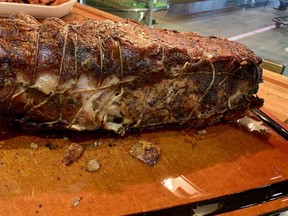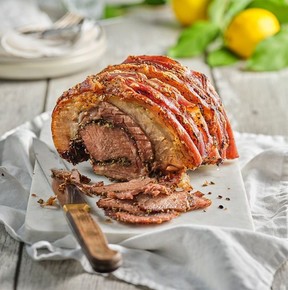
Reviews and recommendations are unbiased and products are independently selected. Postmedia may earn an affiliate commission from purchases made through links on this page.
Article content
It’s one of the best-kept secrets of the culinary world – a savoury, melt-in-your mouth boneless pork that has been stuffed with an array of garlic, herbs and spices, rolled in pork belly, slowly baked to perfection, and just bursting with juicy flavour.
Advertisement 2
Article content
This delicious delicacy is called porchetta – perfect for picnic season, not to mention presenting one for your dad this upcoming Father’s Day weekend. It’s also a wonderful occasion dish for such family events as birthdays, graduations and weddings.
Porchetta isn’t a complicated dish, but it’s detailed, slow roasted for hours until it reaches that perfect pinnacle of flavour and taste that has the capability of making one weak in the knees.
And its crackle lives up to its name with a crunch and flavour ratio like non other.
Such is the allure of this Italian version of pulled pork, also known as porketta, depending on where you purchase it, or which recipe you use. Many regions of Italy claim it as their own – as do other parts of Europe – but it’s a given there are as many versions as there are stars in the sky.
Advertisement 3
Article content
As basic as this pulled pork dish is, the flavour nuances can be subtle or profound, depending on the ancestry of the recipe. And many food companies, restaurants and caterers – even home cooks – who create their own porchetta keep the ingredient list a closely-guarded secret.

It’s pride in ownership, not to mention a reflection of the recipe’s true roots, notes Dante Di Biase, owner of Ontario’s Globe Meats, (globemeatsmarket.com), a decades-old family-run wholesale and retail food company where the porchetta sells out daily before noon. It takes a good 12 hours for the pork to roast before it’s offered up.
“Our recipe is 40 years old, and we haven’t changed one ingredient in all those years,” said Di Biase. “Our family hails from the Molise region of Italy, and we use a selection of herbs and spices known for that area. If you go to northern Italy, the porchetta has similar spices but you can taste the subtle differences. And they serve their porchetta cold, while we serve ours hot or room temperature,” on slider buns with an assortment of toppings, including hot peppers.
Advertisement 4
Article content
Porchetta has been around for decades, but “it has really become popular these last few years,” says Adriano Zito, of Zito’s Marketplace, (zitosmarketplace.ca), again, a decades-old family-run wholesale and retail food business founded in 1985 by Angelo Zito and now run with the help of Adriano, and his brother, Alessandro. The company offers a hot table brimming with dishes created by local “nonnas” or Italian grandmothers, and where porchetta is one of the most popular items on the menu.
“Porchetta has really come into its own these last few years, and it’s building momentum on the food scene across Canada,” says Zito, adding that the dish is in great demand at special events – especially weddings.
The Zitos hail from southern Italy, in particular Calabria and Sicily, and – again – the herbs and spices used in the company’s porchetta are reflective of that part of Italy. Some recipes use a handful of basic, standard ingredients – garlic, parsley, oregano – and some add a touch of daring with coriander or wild Tuscan fennel. Again, it’s all about the recipe’s personality.
Advertisement 5
Article content
“Basically, a good porchetta is defined by the person who makes it, and the fresh herbs and spices used in making it,” says Zito. “In our case, it’s all about the fresh garlic and rosemary … you can actually taste the aroma first.”

Slow Roasted Porchetta
Adapted from a recipe courtesy of award-winning food blogger Isabelle Boucher of crumbblog.com for www.ontariopork.on.ca. Note, you start the roast the night before and then pop it into the oven for a long roasting period. Photo courtesy Isabelle Boucher/Ontario Pork
2-1/2 lb boneless pork butt roast, butterflied
1 fresh pork belly, long enough to wrap around roast
1-1/2 Tbsp. kosher salt
1 Tbsp. fresh ground pepper
2 Tbsp. fennel seed, lightly toasted
1 Tbsp. pickling spice
Advertisement 6
Article content
4 cloves garlic, minced
2 Tbsp. EACH finely chopped fresh thyme, oregano, rosemary and parsley
2 tsp. lemon zest
2 Tbsp olive oil
Using a sharp knife, score skin side of pork belly in a diamond-shaped pattern. Season belly and roast generously with salt and pepper on both sides. Using a spice mill or a mortar and pestle, grind fennel seeds and pickling spices until fine.
In a small bowl, stir together ground spices with herbs, lemon zest and olive oil. Rub mixture onto meat side of the belly, and on top side of pork roast. Carefully roll up roast to enclose marinade, then wrap with pork belly. Tie up with butcher’s twine at 1-inch intervals.
Place porchetta on a wire rack set over a baking sheet, and refrigerate overnight uncovered to allow rind to dry out (this ensures a nice, hard crackling).
Advertisement 7
Article content
Following morning, preheat oven to 250°F. Place porchetta on a wire rack set in a shallow baking pan, and bake in preheated oven for 10-11 hours or until a meat thermometer reads an internal temperature of 195°F. Remove porchetta from oven, and increase oven temperature to maximum (450°F). Return porchetta to oven, and cook for 5-10 minutes or until crackling starts to bubble up all over, watching carefully to make sure it doesn’t burn. (If top of roast starts to brown too quickly before sides have finished crisping up, tent it loosely with a piece of aluminum foil.)
Let roast rest for 10-15 minutes, then cut into thin slices and serve.
Stay connected with us on social media platform for instant update click here to join our Twitter, & Facebook
We are now on Telegram. Click here to join our channel (@TechiUpdate) and stay updated with the latest Technology headlines.
For all the latest Food and Drinks News Click Here

